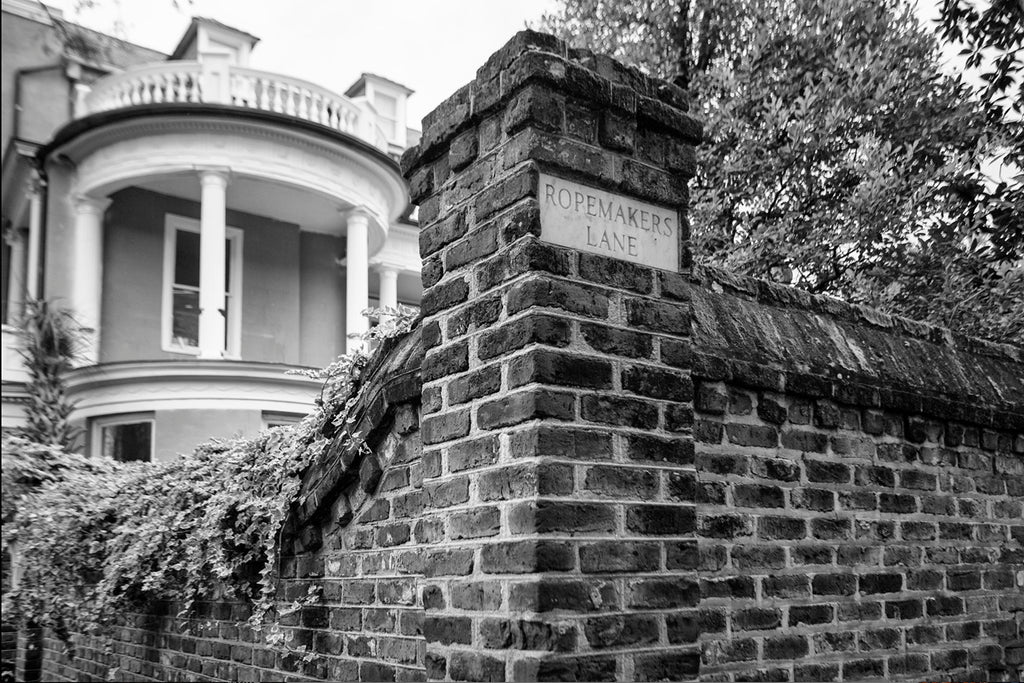
The old rope walk of Charles Snetter’s Rope Manufactory
Charleston, South Carolina has much more than its fair share of scenic streets and historic lanes, many of which have charming or romantic names (Pirate's Alley for example).
But Ropemaker's Lane intrigued me enough that I actually photographed the old, ivy-covered brick wall with its nameplate on the corner of Meeting Street.
I had assumed it was named such because it had once housed a rope making facility or business. Now, thanks to the fantastic information sourced from these two great sites, Charleston Footprints and the Charleston County Public Library, I know the actual story which I'm summarizing here. Be sure to go to the pages for the full details! They're fascinating.
According to Michael Trouche of Charleston Walking Tours, this lane was the site of a rope making enterprise called the Charles Snetter Rope Manufactory a very long time ago — from the 1780s until 1821. But the lane got its name because it was a suitable location for the workers (who were enslaved people) to outstretch the long individual strands of hemp fiber used in rope making. They would walk miles a day up-and-down the lane, twisting and braiding the hemp into rope.
Now, the ground where ropes were hand-twisted over 200 years ago is a shady street lined with multimillion dollar homes!

Screenshot of Charleston's Ropemaker's Lane, courtesy of Google Street View
More history of Ropemaker's Lane and the fate of Charles Snetter
According to the Charleston County Public Library, Ropemaker's Lane was probably established in the 1740s, and was an unofficial path (actually more of a very long courtyard, since it's closed on one end) donated by adjacent landowners, which was a common practice in those days. Because Charleston was platted with a limited number of streets, landowners would agree to donate strips of land for easements, making the subdivision of properties easier. Through common use, these donated paths would eventually become public streets.
This article says the street was called "Rope Lane" prior to the 1950s and in its early days, may have had no name at all. Snetter first appears in the records in 1781, when he leased property along the lane with intent to build a rope making business. His background is unclear, but the article surmises that since he was a loyalist to the Crown, he may have immigrated from England. The property for Snetter's business would have been located on the left, behind the stone wall, in the street view image above.
As can be seen in the historic ad linked below, Snetter made white ropes. That means they were not coated with tar, and were therefore not intended for maritime use, but were rather made for many other dry land purposes such as halters, bed-sacking, and drum cords. He also made threads and twine.
See an ad for Charles Snetters rope business, originally published in the City Gazette in 1796 here.
Snetter died in 1802. He was not married and had no heirs, so he bequeathed his business to some of the slaves who had worked for him, emancipating them at the same time. He owned a home on King Street, which he donated to the Charleston Orphan House.
The freed slaves, Bristol and Sarah Snetter, kept the rope business going until Bristol's death in 1820/21. Sarah died a few years later in a Charleston poor house.
Be sure to check out the library's article, as it has additional illustrations and a really great podcast about Ropemaker's Lane.
Buy a fine art print of this photograph
Ropemakers Lane, Charleston, a black and white photograph by Keith Dotson. Click to buy a fine art print.
Sources
Charleston Footprints, Ropemakers Lane: Charleston Walking Tours by Michael Trouche
Charleston County Public Library, "The Story Behind Ropemaker's Lane"


Leave a comment